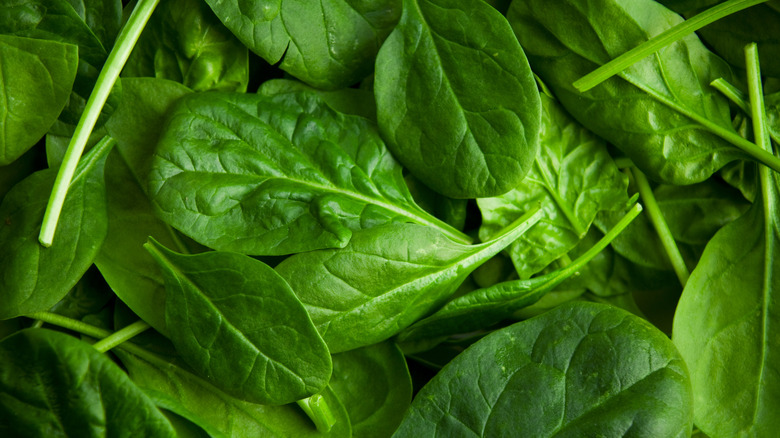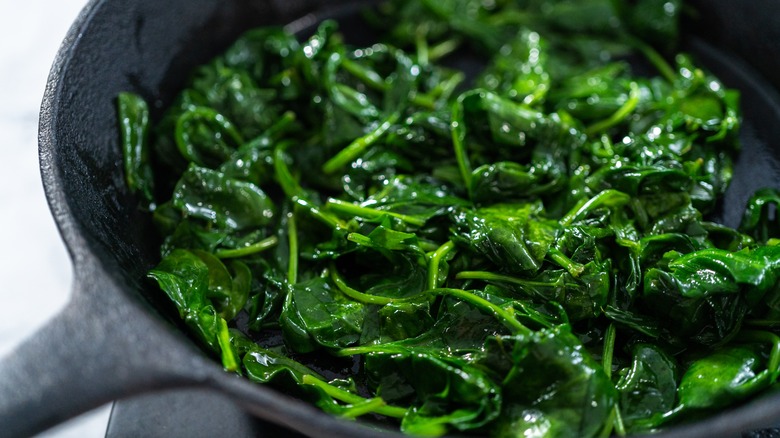Why Chef Jet Tila Never Buys Frozen Spinach
Sorry Popeye, it turns out fresh spinach is best. At least, that is, according to celebrity chef and cookbook author Jet Tila, who makes the case for buying fresh leafy greens rather than the frozen (or canned) variety. As Tila believes, the humble ingredient can add a range of textures and flavors to dishes, but it changes depending on how much it's cooked — but the same can't always be said of its frozen counterpart.
Tila even goes as far as to argue that frozen spinach is its "own food group" (via Food & Wine), adding, "Most frozen leafy vegetables lose all their texture and vibrancy when frozen." This happens because water, including stubborn ice crystals, will cause leaves to wilt and turn faster.
This is not to ignore the fridge-saving benefits of the frozen stuff, but rather to remind busy shoppers to spend time in the produce aisle, too. In fact, you may want to get both types and use them accordingly, depending on the recipe.
The difference between fresh and frozen spinach
To freeze piles of iron-rich spinach, manufacturers typically chop and blanch the delicate leaves to get them ready — and that comes at the detriment of the meal you're making with them. No matter how briefly you cook the leaves, heat will inherently change the texture and color of spinach and other greens. This makes a big difference in quick-cooking recipes like omelets and raw mixtures like smoothies, where limp greens can get lost or weigh down light flavors.
If you're trying out a new dish, it can also be frustrating to discover just how much water frozen spinach releases as it defrosts. Though this won't matter as much in something like soups, a waterlogged lasagna is a whole different ball game. For this reason, resist the temptation to swap frozen and fresh leaves interchangeably: Fresh spinach cooks down dramatically — one pound cooks down to approximately a cup — and can throw off the ratios in your recipe.
Spinach isn't the only ingredient that changes texture during its time in the deep freeze, either. Even firm leaves like Swiss chard and collards can be affected and deserve a fresh start when possible. Like spinach, these greens retain more of their chew when cooked raw, and you may find them easier to simmer without heading into baby food territory.
Meals where fresh spinach shines
There are so many ways to use fresh spinach beyond just a salad base or side dish. Try using just-cooked spinach and crumbled feta to upgrade a homemade meatloaf. Or follow Jet Tila's lead and quickly wilt baby greens to deepen punchy dan dan mian noodles.
The mild taste of spinach also provides a welcome foil for rich or sharp ingredients. The greens can cut through cheesy quiches or quesadillas without taking away from their luxurious flavors. Smoothie enthusiasts like spinach's earthy flavor to balance tart apple, sweet pineapple, and even nutty peanut butter.
Chefs also use the ingredient to walk the line between raw and cooked, taking advantage of carryover cooking. Italian wedding soup recipes, for example, call for cooks to add handfuls of the leaves after turning off the stove. As the comforting soup gets reheated, new textures and flavors are pulled from the greens. In pasta salads, hot noodles ever-so-gently soften the crisp vegetable. With so many ways to utilize the leaves, you may want to stock up next time you're in the produce aisle.



